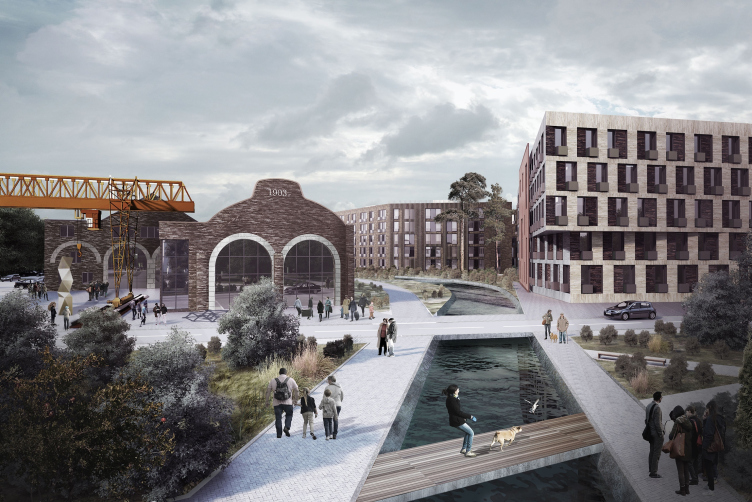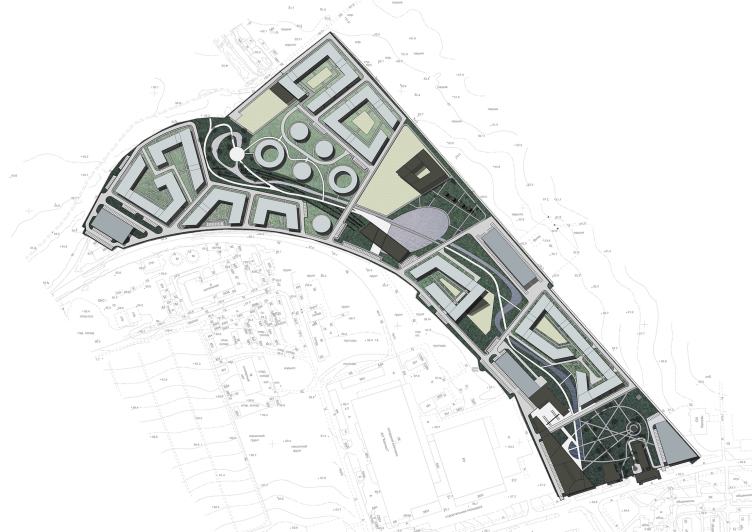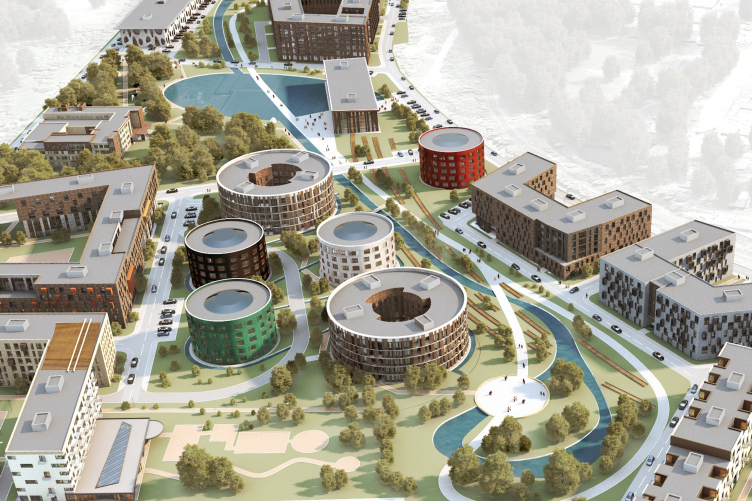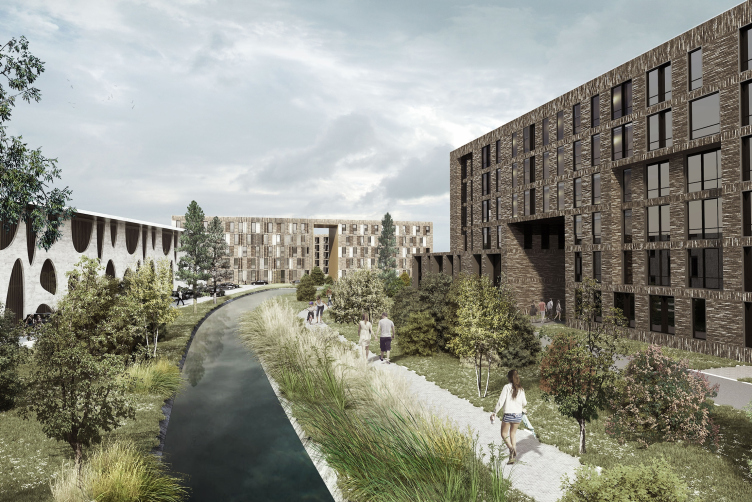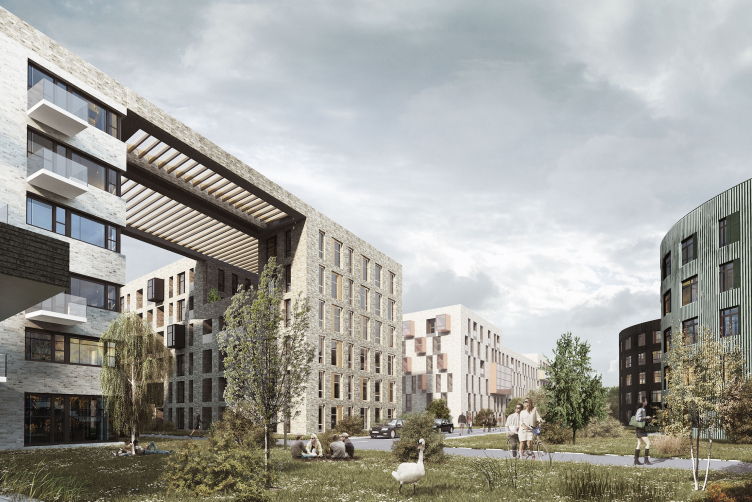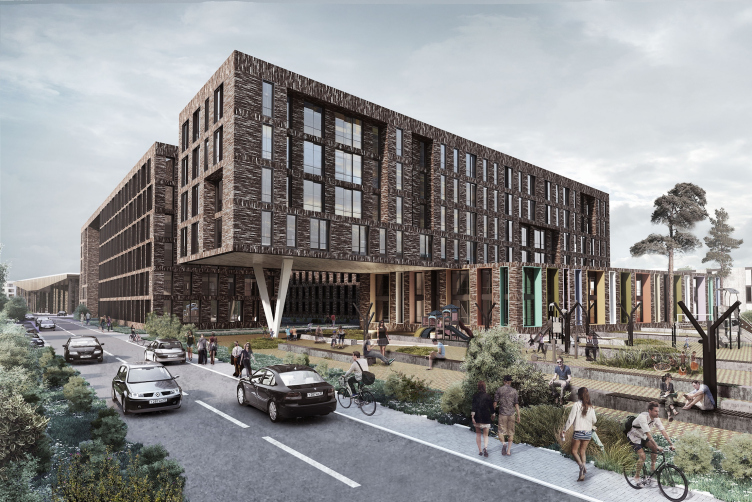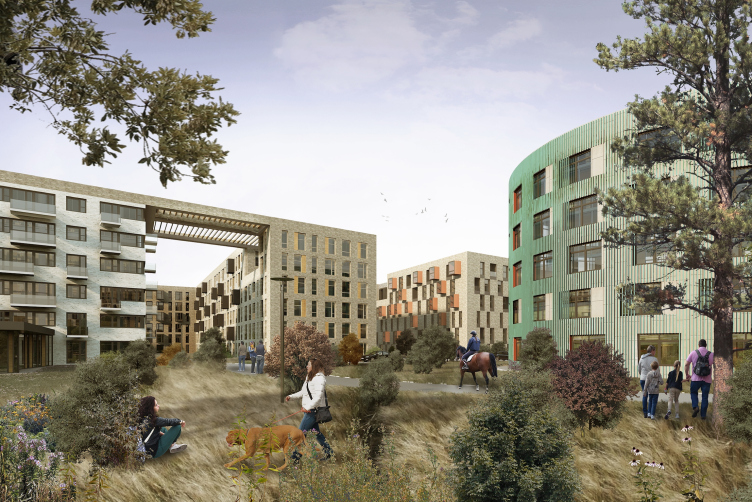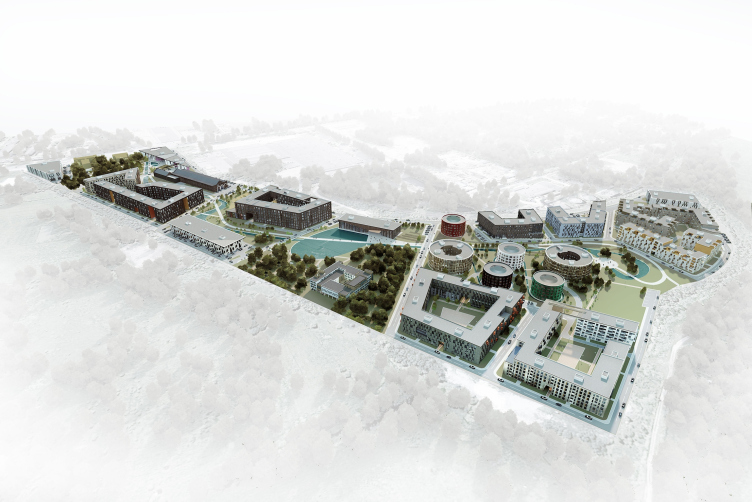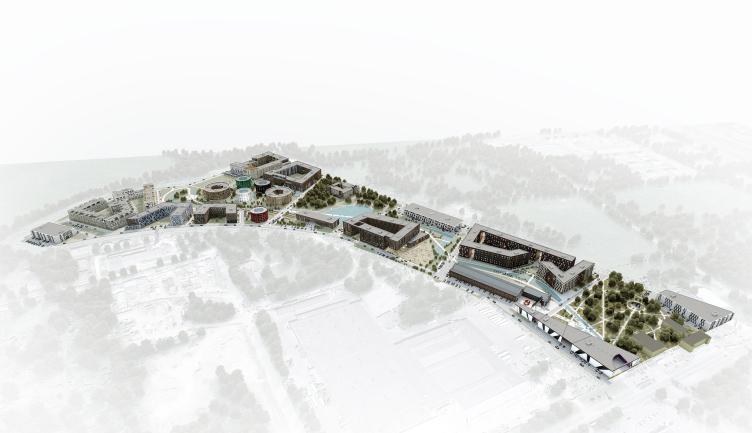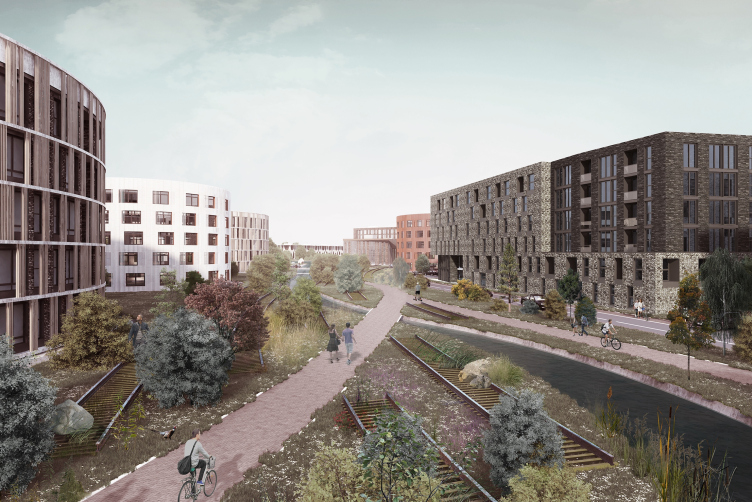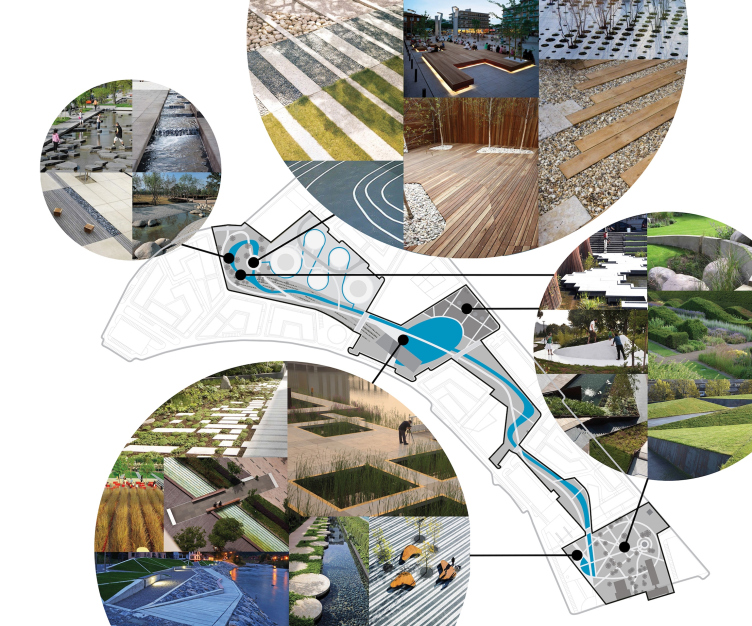The territory of Tsarskoselsky railway-car repair plant “Sofia” in the outskirts of Pushkin, just as any pre-revolution industrial facility subject to redevelopment, contains multiple cultural layers that can be described by the word “palimpsest”. For project designers, this literal “showthrough” of historical layers through time often not only concerns artefacts which are found a suitable role in the new building development, but also the city-planning structure, the scale and principles of morphology. To different extents, the participants of the tender for development concept of the plant territory laid an emphasis on preservation of the traces of history. The proposal of PANACOM was no exception, but the architects went further by implementing the main principles of working in a historical context with the means of modern architectural language.
According to the design specification of the tender, this heel-shaped territory, where the most significant artefacts have concentrated southwards, is subject to mixed site-development with residential blocks, apartment hotels, a business and cultural centers, social infrastructure and a public center with shopping and entertainment functions and a sports facility. Closeness of the town Pushkin with its famous parks – Alexander and Catherine parks – surely projects its imagery to the planning site. However, the PANACOM architects did not bring here the classic net of blocks as it is; they used the semiotic and structural features of the classical language, in this way preserving the connection with tradition, without turning it into imitation.
The concept of developing the territory of the former Tsarskoe Selo railway-car repair works "Sophia" . Project, 2016 © PANACOM
The concept of developing the territory of the former Tsarskoe Selo railway-car repair works "Sophia" . Master plan. Project, 2016 © PANACOM
“The image of St. Petersburg, the image of Pushkin and this whole area certainly dominate over this territory,” says Arseniy Leonovich. “That is why, there is room for historicism and some classical things worth linking to – but figuratively, not head-on, with iron benches and street lights… We saw our task in conveying the spirit of the time and place, of a powerful, rejuvenating city-planning impulse, which is associated with the build-up of this agglomeration of St. Petersburg, and is the prototype for the new stage of city-planning history. This is a sort of looking back at Holland, at the Germans – in a good way. The leitmotif of our project is an insight to the history, without imitations”.
First of all, PANACOM considered the genesis of this territory, which obtained such odd outline with a “beak” in the south-west part thanks to the curve of a railway road that used to go inside the lot. This dynamic line suggested the geometry of the main planning axis of the new urban-development formation – chains of water areas.
The concept of developing the territory of the former Tsarskoe Selo railway-car repair works "Sophia" . Project, 2016 © PANACOM
Water
In this concept – just as in St. Petersburg itself – water is the leitmotif and the planning “backbone”. Chanels, ponds, a “loop” with an island, a zig-zag stream: they suck in and thread – as if on skewers – this gigantic tumbling territory, connecting the blocks with infrastructure facilities and the public area in front of the shopping center. Walking, sporting and byking tracks are beaded onto the planning axis of the boulevard system.
The concept of developing the territory of the former Tsarskoe Selo railway-car repair works "Sophia" . Project, 2016 © PANACOM
The concept of developing the territory of the former Tsarskoe Selo railway-car repair works "Sophia" . Project, 2016 © PANACOM
“Closed Facades”
The second classical principle in formation of a city like St. Petersburg – “closed facades”, a foregoer of the block build-up – is implemented in the construction of residential houses. They are arranged equally high blocks, six floors each, but with various plastic and individual modern designs. Uniformity of height and the block-wise build-up principle allowed the PANACOM architects to link their project to St. Petersburg context, and, on the other hand, win a pragmatic advantage of rather high density values. The square line of the houses follows the contour of the territory and form private residential yards, separating private and public lives.
The scale is set by the large divisions with emphasized risalits, as well as the giant arches, three-five storeys high. As required by the design specifications, the houses remain independent, with two, three and four entrance halls, but they look like monolite blocks. The interchange of meridional and latitudinal sections allowed the authors to diversify apartment layout.
The concept of developing the territory of the former Tsarskoe Selo railway-car repair works "Sophia" . Project, 2016 © PANACOM
The concept of developing the territory of the former Tsarskoe Selo railway-car repair works "Sophia" . Project, 2016 © PANACOM
Apartments
A plastic and color accent of the residential part is the apartment complex in the forms of disk-houses and cylinder-houses. The low-rise towers inside this cluster can be differentiated by size, while retaining the same height of five high-ceiling floors. Spatially, this agglomeration is connected by a stream wrapping around the buildings and creating impressive reflections.
“According to the assignment, a big number of square meters is to be built-up with apartments. We think that something special cound be made in this segment,” says Arseniy Leonovich. “According to their status, apartments are second-range accomodation. They call for different approach to life, and to planning, and to the standards. We made some of the houses wothout clearly defined yards, although groupped on one territory they surely form their special architectural experience in the space on the landscape”.
The concept of developing the territory of the former Tsarskoe Selo railway-car repair works "Sophia" . Project, 2016 © PANACOM
Transport
In most of the cases, the drive-ups to the houses are arranged only from the outside, practically eliminating transit of vehicles through the residential complex. The main dual artery is brought out to the periphery, to the west and south-west borders. Starting from Kuzminskoye Schosse, passing along the site border, it runs out near the planned parking space in the west part, and goes down to Peterburgskoye Schosse, on the track of presently unsurfaced road. Such connection of a lot to two highways at once improves the quality of its transport scheme.
The concept of developing the territory of the former Tsarskoe Selo railway-car repair works "Sophia" . Project, 2016 © PANACOM
Public Areas
The territory of the new district is functionally divided into two unequal parts – the larger residential, and the smaller public one. The system of visual restrictions allows to maintain this division without fences and barriers. With common use in mind, the part close to Kuzminskoye Schosse places a public center, some buildings of which are pre-revolutionary. This place is energized with history and traces of time; here are the buildings of plant management and workshop pavilions, by whose side appears the new shopping center. It includes the part of the pavilion under restoration, as well as the artefacts of the existing plant: a crane bridge and fragments of rails. Nearby, there is a Memorial Park – it is created on the basis of the existing garden by the building of the health safety management; this is the place that the family of thr last Russian Emperor left when going into banishment. At the crosspoint of two planning axes of the park, the authors suggest building a chapel. The second public center, created for convenience of the residents of the new block, appears at the embankment of a man-made oval pond in the middle of the district: here, the authors placed compact and modern constructions of commercial and sporting buildings.
The concept of developing the territory of the former Tsarskoe Selo railway-car repair works "Sophia" . Project, 2016 © PANACOM
The concept of developing the territory of the former Tsarskoe Selo railway-car repair works "Sophia" . Project, 2016 © PANACOM
Parks
Presence of famous garden and park ensembles at close vicinity forced the authors of the concept not to follow the path of imitations, but to interpret beautification in a modern way, but at the same time preserving the classical principle of interchange of dense build-up of residential blocks with open green public areas. The site improvement becomes a chain of micro-environments, with their “scenarios” superseding throughout the whole “green” planning axis. Various types of paving, timber decking, different grasses, gabions, local lighting of the benches, sculptures and lawns, as well as the one built-in the paving of the lanes and alleys; surface and vertical architectural lighting, bridges over the canals; stony, batten and turf covering of the embankment – this is just part of the specter of modern instruments used for creation of a comfortable and conceptual landscape. The architects also found use in the tradition construction of mansion ensembles with interchange of dense and unloaded areas, with dividing a park into a representative, regular and more private, picturesque parts.
“It was important for us to interpret the territory in large pieces, so we proposed to nominally divide it into three thematic parks: the memorial park, the “English” landscape park and the “French” regular one,” says Arseniy Leonovich. “We sought to make people living in a new city get the feel of the history of this place”.
The concept of developing the territory of the former Tsarskoe Selo railway-car repair works "Sophia" . Project, 2016 © PANACOM
The concept of developing the territory of the former Tsarskoe Selo railway-car repair works "Sophia" . Project, 2016 © PANACOM


